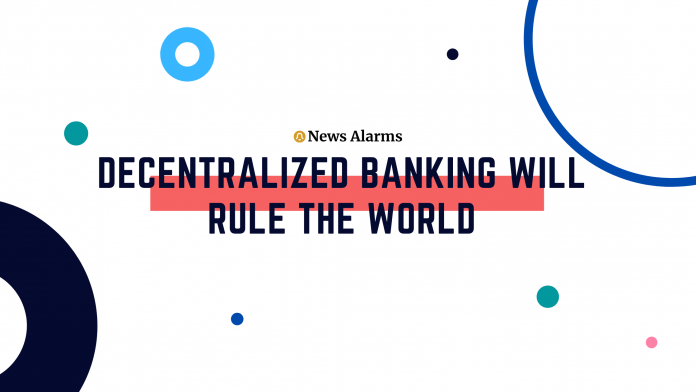Decentralized Finance (DeFi) is the latest rage for 2020. You may call it the flavor of the year on the crypto market and in financial investment in general if you will.
DeFi projects are skyrocketing in value from zero to hundreds of millions in just a few weeks. New tokens become prized assets soon after they launch. Everyone wants a piece of the pie, and if you’re late for dinner, there might not even be any crumbs left to settle for.
As is the case with every innovation, there are a few cynical, pessimistic concerns that DeFi is just another financial bubble waiting to burst.
However, there are many more signs pointing in the opposite direction. And, these signs show that DeFi might be just one of the first decisive steps towards a future where decentralized banking will rule the world.
What is so special about DeFi?
Decentralized banking stands for a collection of financial apps that coexist in an ecosystem built on top of the blockchain. The development of new DeFi applications enhances this network and transforms it into an open-source, permissionless, and transparent platform that does not depend on a central authority.
Users can interact in decentralized banking through decentralized applications (DApps). They have complete control over their assets and use smart contracts to compensate for the absence of a third-party for validating transactions.
Contrary to traditional banking institutions, the DeFi ecosystem does not require the control or intervention of human-run centralized governance. Every user can contribute to the network by creating and executing applications.
Decentralized banking benefits from one of the most important innovations that Ethereum introduced to blockchain technology: smart contracts.
A smart contract is an electronic protocol between two or more parties that facilitates the negotiation and execution of an agreement. It also validates its outcome depending on the conditions set by the participants, if and when they are met.
Since smart contracts are self-executing, there is no need for a central authority to validate them. Users can engage in financial transactions, crypto exchanges, loans, and investments without a third party (e.g. traditional banks) overseeing or charging fees for these operations.
How Decentralized Banking works
At first, decentralized banking may seem like an out-of-this-world concept. The easiest way to understand it is to look at a few traditional financial operations and see how they work in the DeFi ecosystem.
Some of the most notorious banking operations combine with decentralized banking facilities to enable DeFi users the access to:
- Borrowing and Lending contracts
- Monetary banking services
- Decentralized exchanges
Let’s break them down and see how decentralized banking makes these traditional financial mechanisms more user-friendly!
1. Borrowing and Lending Contracts
In any other circumstances than the classic banking environment, borrowing and lending money without the supervision of a third party may seem like a dangerous, if not an illegal practice. However, decentralized banking makes it possible in an entirely safe form that is cheaper, faster, and more easily available than through an intermediary.
Through smart contracts, users can borrow digital assets and use them to fund a project. Just as well, investors can lend their assets to the development of applications and earn interest. When the application reaches its goals, the developers get a finished product that they can utilize or sell, and the investors get their money back. Everyone wins, except for the traditional banks who watch grudgingly from the sides.
2. Monetary Banking Services
DeFi and decentralized banking should provide a solution to intense price volatility, which is the main impediment for global cryptocurrency adoption.
The solution lies in the issuance, distribution, and use of stablecoins. Since their ascent to popularity, DeFi applications have emerged as prominent stablecoin developers.
Stablecoins are crypto assets that are pegged to other assets to maintain price consistency and stability. These features make them ideal for everyday transactions and intermediary coins in the exchanges between different cryptos.
There are three kinds of stablecoins:
- Pegged to Fiat Assets
- Pegged to Crypto Assets
- Not Pegged to Anything
Stablecoins Pegged to Fiat Assets
Fiat-collateralized stablecoins are the first form of pegged digital assets. The process of development and issuance is simple, at least in theory. The company behind the stablecoin locks collateral, which can be in the form of fiat currency, gold, oil, etc., which represents the entire amount of pegged cryptos in circulation.
Some of the most popular examples of cryptos pegged to fiat assets include Tether (USDT) and Petro, which is Venezuela’s oil-backed stablecoin.
Stablecoins Pegged to Crypto Assets
This type of stablecoin does not use a 1:1 ratio of collateralization. Instead, it fights volatility by asking users to lock a larger amount of the pegged asset. So, for example, if you want $50 worth of particular Ethereum-pegged crypto, you will have to deposit $100 worth of Ether for it.
One of the most popular examples of stablecoins pegged to crypto-assets is MakerDao’s Dai.
Stablecoins Not Pegged to Anything
In this case, the issuance of stablecoins is determined and ensured by a smart contract. If the value of each stablecoin fluctuates, then the contract will use the additional supply of coins to re-balance the price.
The advent of stablecoins should make everyday transactions much simpler, faster, and cheaper. It should also help people apply for mortgages and insurances on more convenient terms.
3. Decentralized Exchanges
Decentralized banking does not only revolutionize traditional financial systems. It also innovates the young crypto industry. A good example of it is the rise of decentralized exchanges (DEX), which do not only compete with classic banks but with crypto exchanges as well.
Until now, two or more crypto holders had to go through a centralized exchange like Coinbase or Binance among others to trade cryptocurrencies. The fees would usually be smaller and the transaction times faster than any traditional bank could provide. So, everyone’s happy.
However, in decentralized banking, crypto owners can trade digital assets directly, and without any type of intermediary. On decentralized exchanges, the fees are significantly smaller even than on centralized exchanges, and transactions are almost instant. So, everyone’s even happier.
Hot DeFi Applications Now
There are plenty of examples of DeFi applications that you can research if you wish to test the waters of decentralized banking. We want to save you a bit of time by presenting some of the hottest ones at the moment.
Dharma
Dharma is an Ethereum-based peer-to-peer platform where users can lend or borrow digital assets. The application is not fully centralized, but it supports DAI, ETH, and USDC for collateralization. The average collateral ratio is 210%, and the interest rates are different for each coin.
One of the best things about Dharma is that it lets users lend and borrow coins for 90 days at a fixed interest rate. If borrowers pay the loan back before the 3-month period expires, they still have to pay the entire interest that would apply for 90 days.
Compound
Compound is an Ethereum-based protocol for various cryptocurrencies. Users can lend and borrow BAT, DAI, ETH, USDC, REP, ZRX tokens through the platform’s native tokens cToken (cBAT), and COMP.
Compound works as a liquidity pool type peer-to-peer platform where the interest rate is not fixed. The value of the interest rate varies depending on the interest of every market available on the protocol. The lending interest rate is always lower than the borrowing rate to offer more liquidity. The average collateral ratio here is 400%.
Maker
One of the best-known DeFi applications is Maker, which is an Ethereum-based platform. Its native stablecoin, DAI, is softly pegged to USD, and it does not lack a popularity badge either.
On Maker, users can borrow DAI after placing ETH token in reserve in Collateralized Debt Position (CDP). The loans here are over-collateralized at a rate above 150% at the beginning of the loan – around 480%.
Contrary to peer-to-peer DeFi applications, Maker users reserve pools to issue coins and allow users to participate in the operational earnings through “governance fees,” which act as interest rates for the network.
One of the best things about Maker is that users can deposit multiple assets as collaterals (in single borrowing) to diminish the volatility of a specific asset.
The Benefits of DeFi and Decentralized Banking
The traditional banking system has evolved through the centuries, but the presence of an intermediary has always been a fundamental condition of its functioning. Until now!
Decentralized banking through the development of DeFi applications is about to overhaul asset transactions and provide essential benefits, such as:
- No fees for third-parties
- Instant transaction settlements
- No censorship or restrictions imposed by a central authority
- The development of DeFi is available to anyone and everyone
- Improved borrowing and lending money conditions for low-income regions
- No credit checks
- The option to collateralize digital assets, and not only physical possessions
Conclusion: Why Decentralized Banking Will Rule the World
Through the development of decentralized finance applications, investors will have a new market to explore and perpetuate. Crypto owners will discover new ways of financing projects and advancing the cryptocurrency ecosystem far enough to make global adoption finally possible.
The advantages of decentralized banking will eventually transgress the users of blockchain technology and reach the common folk. As an alternative to the traditional banking system, it will provide people with better terms when borrowing or lending funds, and for when they fund a business or a project.
Will this mean the end of the classic bank as we know it? Certainly not, but the centuries-old institution will have to adapt to get a fair slice of the pie as well.


